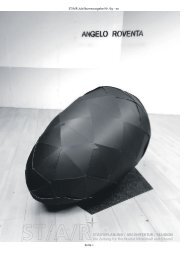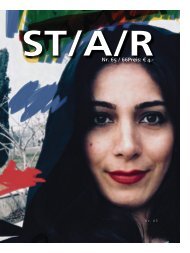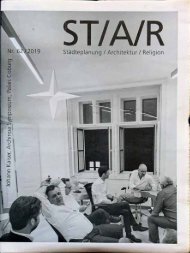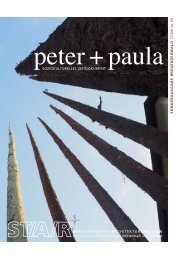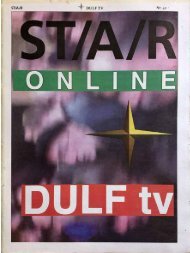ST/A/R-50-54 (Seiteneindrücke)
Erfolgreiche ePaper selbst erstellen
Machen Sie aus Ihren PDF Publikationen ein blätterbares Flipbook mit unserer einzigartigen Google optimierten e-Paper Software.
18 <strong>ST</strong>/A/R/T +<br />
Nr. <strong>50</strong>/2016<br />
Nr. <strong>50</strong>/2016<br />
+ <strong>ST</strong>/A/R/T 19<br />
Contributions: Max Henry<br />
Tamuna Sirbiladze -kill all your darlings<br />
In one form or another every painter's output is autobiographical. A<br />
necessary combination of physical stamina and mental acuity marks<br />
the progression of time. Embedded within the material results are the<br />
emotive rhythms of one's daily cycle. Expressed with coo l ana lytic detachment<br />
or marked by a sorrow that turns into rage these actions are<br />
a progression of weeks, months, and years accrued into an oeuvre. We<br />
get to know someone through his or her art or rather that unspoken<br />
otherness that's unique to each individual temperament.<br />
Tamuna Sirbiladze kept up a rigorous studio schedu le, the paintings<br />
accwnulated--she usually had severa l !arge, medium, and sma ll<br />
formats going at once wit hout missing a beat. Everything came in<br />
bunches; her colors found their own logic, patterns developed. You<br />
cou ldn't categorize Tamuna as singu larly abstract though. Her interlocking<br />
shapes often embedded anthropomorp hic forms (eyes, bod.ies,<br />
heads) or incorporated still life objects (such as pomegranates) that are<br />
totally her own. The 2015 exhibition "Good Enough, Is Never Good<br />
Enough" was her coming out sho w at James Fuentes, New York. Some<br />
of the oil stick and pastel paintings were large-sca le banners flat on the<br />
wall, others on the requisite stretcher. This choice selection of pictures<br />
was weil ed.ited and announced a seasoned artist. Unafraid of the gestura<br />
l and quirky this was Tamuna at her ebullient best.<br />
How to overcome the limitations of the stretcher is a considerab le issue<br />
facing the contemporary painter. This never daunted Tamuna, who<br />
painted with an insouciant attitude towards rigid formalism. She leaned<br />
groups of paintings on the wa ll th at you could parse through like<br />
posters in a rack. Her site-specific interventions d.ispensed with conventiona<br />
l painting installations, either directly on wa lls overlaid with<br />
standard raw canvas works or in cube structures adorned with staccato<br />
mark making. In a 2012 solo, she took command of the space in "this is<br />
not a gallery" by installing floor to ceiling canvases among the rooms.<br />
A coup le of canvases totally covered the big windows although still<br />
allowing natural light to seep through.<br />
Such an unexpected encounter with a painting installation emphasized<br />
Taumuna's idiosyncratic approach to exhibition making. Over and<br />
again she sought to defy the bourgeois conventions of painting d.isplay.<br />
Hen ce the "cube" paintings hint at a dilemma about the consumerist<br />
white cube by offering us a box within the standardized box, set upon<br />
the floor rather than a sterile wa ll.<br />
Tamuna was often full of surprises, some of which I couldn't reconcile<br />
as she experimented with numerous forms. Many were delightful<br />
oddities that seemed to me one offs that she couldn't help but produce,<br />
perhaps to alleviate the intensity of finishing a new series with deadlines<br />
for shows fast approaching. Among my personal favorites is the<br />
enigmatic "White Co lumn s': 2011 a sizable (2 x 3 meter) horiz onta l<br />
picture. Two vertica l columns of said title appear like stacked asymmetrical<br />
vessels about to topple. Set amidst neutral gray, off whit e, and<br />
pastel shades of pink and yellow, the background's rough patchwork of<br />
tonal variation emits the stillne ss found in a Giorgio Morandi still life.<br />
Here she captured the noble silent life of a room space set in time that<br />
is neither of the past nor of the future. An artist who hits their stride<br />
in the studio is by will creating a ripple in time. It's evident when the<br />
work gets exhibited, and gives credence to the hypothesis abo ut the<br />
aura of the art object. Abstract gestures gave Tamuna improvisatory<br />
expression while elements of representation and the figure gave her<br />
grounding. From her early formative days in Tbilisi, dassical underpinnings<br />
and the Byzantine, remain "hidden" in her work. Frequent visits<br />
to the permanent collection ofVienna's Kunsthistorische Museum,<br />
and when traveling, the Met Museum, NY, the Louvre in Paris, or the<br />
Museo di Capodimonte in Naples inspired a figurative series titled ''V<br />
Co llection''. Details of these canonic paintings were appropriated from<br />
book reproductions, phone snaps hots, and sense memory. For her<br />
2013 exhibition, a salon hang of severa l sma ll to mid-sized canvases<br />
adorned the wa lls. Caravaggio, Giotto, Raphael, Velazquez; the titans<br />
of the canon were her muse and accomp lice in cropped paintings that<br />
retain a corresponding resonance wit h th e original. Raphael's "Portrait<br />
ofCardina l Alessandro Farnese" has an especia lly compe lling presence<br />
with its hold shadowy red garment, skullcap, and ground . This is a man<br />
who ascended to the papal throne during tumultuous times after the<br />
fall ofRome in 1527. He looks askance as ifhe's about to reprimand a<br />
subordinate . The eyes project the intrigue ofthe persona in this d.istillation<br />
that destroys Raphael's portrait of the cardina l whilst remaining<br />
true to its essence of power and intrigue.<br />
"In writing, you must kill all your darlings", said the American author<br />
and Nobel laureate William Faulkner. This quote most certain ly applies<br />
to the painter's trade that encompasses Tamuna's very productive last<br />
few years. A close-up of Caravaggids cardsharp picture makes for a<br />
good examp le in assessing the creator-destroyer myth of all painters.<br />
The chiaroscuro of the baroque master is employed but conjured out<br />
of more rudimentary details. The moral of the enduring story is alte red<br />
from one of urban deception to a metaphor on the fate of the cardho l<br />
der. The naivete of the sitter becomes a folkloric tale on purity throu gh<br />
color, line, and forms in space .<br />
In life and art Tamuna Sirbiladze played her cards weil. She "killed" all<br />
her darlings in direct pursuit of that cognitive moment between chance<br />
and fate. She was a force of personality, fierce and stoic to the end.<br />
With th ese thoughts on my mind, l'11 conclude with the wise words of<br />
Cacamatzin:<br />
Who in the end is spared from leaving, despite his gold and all his jade<br />
Is everyone not bound to go there<br />
Am I a shie ld of turquoise, a stone set in mosaic<br />
Will I ever wa lk this earth again<br />
W ill they shroud me in fine mantels<br />
Contributions:<br />
Lia Gulua<br />
Contributions: Natia Kalandaze<br />
Little Sour Fruits<br />
Contributions: Julie Ryan<br />
The locations were scattered across Vienna, mostly in public<br />
space along the Prater and Augarten parks. Others were on<br />
private property. I did most of the tree climbing while Tamuna<br />
scouted for the next place to pillage , both in search of<br />
little sour fruits.<br />
,,/ do not know what the name is in English" she explained ,<br />
nor could she. There is no name for an unripe plum in English<br />
or German, just words for unripe as in not ready to be<br />
eaten or given a name yet.<br />
Tamuna loved these fruits. There were always baskets of<br />
nuts in shells at our apartment , or any place I ever saw her<br />
at home in, with a pomegranate and the odd piece of hard<br />
candy plucked from a hotel she had stayed at.<br />
Photo: Julie Ryan<br />
Pomegranates needed patience , and Tamuna would wait for<br />
their skins to lose a little shine and become leathery to fully<br />
appreciate their singular sourness. We would sit for hours,<br />
as one can in a cafe culture driven city like Vienna, and pick<br />
at fruits and drink chai and coffees and unravel.<br />
Sweet friends bound by sour fruits and the kind of time that<br />
binds people to places neither knew as first homes.<br />
Tammrn in sn1dio with "Whi te Columns" Tamuna Sirbiladze "Whi te Column s" Oil Stick/Acry lic on Canvas, 200 x 300 cm (20 11)





